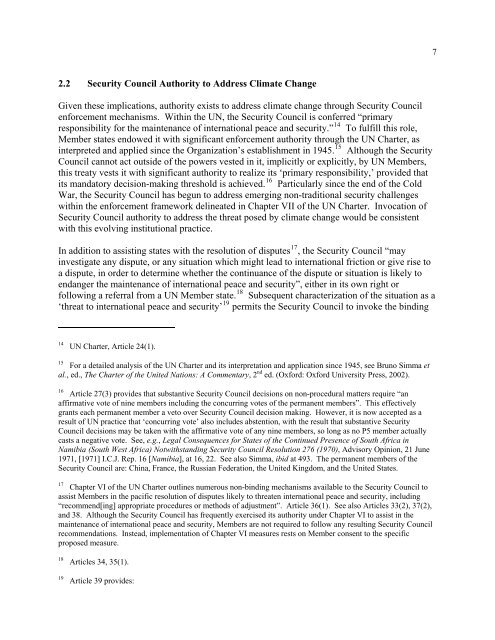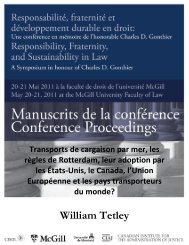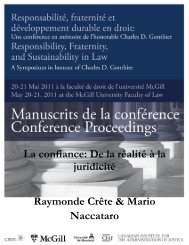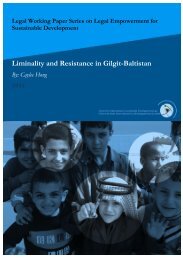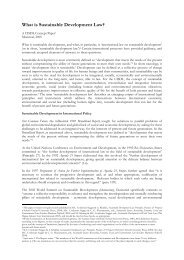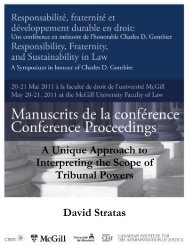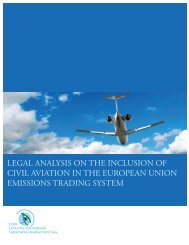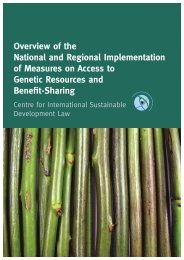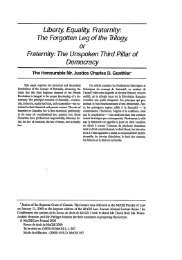Climate Change and the Security Council - CISDL
Climate Change and the Security Council - CISDL
Climate Change and the Security Council - CISDL
Create successful ePaper yourself
Turn your PDF publications into a flip-book with our unique Google optimized e-Paper software.
7<br />
2.2 <strong>Security</strong> <strong>Council</strong> Authority to Address <strong>Climate</strong> <strong>Change</strong><br />
Given <strong>the</strong>se implications, authority exists to address climate change through <strong>Security</strong> <strong>Council</strong><br />
enforcement mechanisms. Within <strong>the</strong> UN, <strong>the</strong> <strong>Security</strong> <strong>Council</strong> is conferred “primary<br />
responsibility for <strong>the</strong> maintenance of international peace <strong>and</strong> security.” 14 To fulfill this role,<br />
Member states endowed it with significant enforcement authority through <strong>the</strong> UN Charter, as<br />
interpreted <strong>and</strong> applied since <strong>the</strong> Organization’s establishment in 1945. 15 Although <strong>the</strong> <strong>Security</strong><br />
<strong>Council</strong> cannot act outside of <strong>the</strong> powers vested in it, implicitly or explicitly, by UN Members,<br />
this treaty vests it with significant authority to realize its ‘primary responsibility,’ provided that<br />
its m<strong>and</strong>atory decision-making threshold is achieved. 16 Particularly since <strong>the</strong> end of <strong>the</strong> Cold<br />
War, <strong>the</strong> <strong>Security</strong> <strong>Council</strong> has begun to address emerging non-traditional security challenges<br />
within <strong>the</strong> enforcement framework delineated in Chapter VII of <strong>the</strong> UN Charter. Invocation of<br />
<strong>Security</strong> <strong>Council</strong> authority to address <strong>the</strong> threat posed by climate change would be consistent<br />
with this evolving institutional practice.<br />
In addition to assisting states with <strong>the</strong> resolution of disputes 17 , <strong>the</strong> <strong>Security</strong> <strong>Council</strong> “may<br />
investigate any dispute, or any situation which might lead to international friction or give rise to<br />
a dispute, in order to determine whe<strong>the</strong>r <strong>the</strong> continuance of <strong>the</strong> dispute or situation is likely to<br />
endanger <strong>the</strong> maintenance of international peace <strong>and</strong> security”, ei<strong>the</strong>r in its own right or<br />
following a referral from a UN Member state. 18 Subsequent characterization of <strong>the</strong> situation as a<br />
‘threat to international peace <strong>and</strong> security’ 19 permits <strong>the</strong> <strong>Security</strong> <strong>Council</strong> to invoke <strong>the</strong> binding<br />
14<br />
UN Charter, Article 24(1).<br />
15<br />
For a detailed analysis of <strong>the</strong> UN Charter <strong>and</strong> its interpretation <strong>and</strong> application since 1945, see Bruno Simma et<br />
al., ed., The Charter of <strong>the</strong> United Nations: A Commentary, 2 nd ed. (Oxford: Oxford University Press, 2002).<br />
16<br />
Article 27(3) provides that substantive <strong>Security</strong> <strong>Council</strong> decisions on non-procedural matters require “an<br />
affirmative vote of nine members including <strong>the</strong> concurring votes of <strong>the</strong> permanent members”. This effectively<br />
grants each permanent member a veto over <strong>Security</strong> <strong>Council</strong> decision making. However, it is now accepted as a<br />
result of UN practice that ‘concurring vote’ also includes abstention, with <strong>the</strong> result that substantive <strong>Security</strong><br />
<strong>Council</strong> decisions may be taken with <strong>the</strong> affirmative vote of any nine members, so long as no P5 member actually<br />
casts a negative vote. See, e.g., Legal Consequences for States of <strong>the</strong> Continued Presence of South Africa in<br />
Namibia (South West Africa) Notwithst<strong>and</strong>ing <strong>Security</strong> <strong>Council</strong> Resolution 276 (1970), Advisory Opinion, 21 June<br />
1971, [1971] I.C.J. Rep. 16 [Namibia], at 16, 22. See also Simma, ibid at 493. The permanent members of <strong>the</strong><br />
<strong>Security</strong> <strong>Council</strong> are: China, France, <strong>the</strong> Russian Federation, <strong>the</strong> United Kingdom, <strong>and</strong> <strong>the</strong> United States.<br />
17<br />
Chapter VI of <strong>the</strong> UN Charter outlines numerous non-binding mechanisms available to <strong>the</strong> <strong>Security</strong> <strong>Council</strong> to<br />
assist Members in <strong>the</strong> pacific resolution of disputes likely to threaten international peace <strong>and</strong> security, including<br />
“recommend[ing] appropriate procedures or methods of adjustment”. Article 36(1). See also Articles 33(2), 37(2),<br />
<strong>and</strong> 38. Although <strong>the</strong> <strong>Security</strong> <strong>Council</strong> has frequently exercised its authority under Chapter VI to assist in <strong>the</strong><br />
maintenance of international peace <strong>and</strong> security, Members are not required to follow any resulting <strong>Security</strong> <strong>Council</strong><br />
recommendations. Instead, implementation of Chapter VI measures rests on Member consent to <strong>the</strong> specific<br />
proposed measure.<br />
18<br />
19<br />
Articles 34, 35(1).<br />
Article 39 provides:


